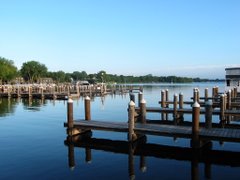The Lake Minnetonka Conservation District (LMCD) is contemplating replacing a damaged harvester (the LMCD’s harvester fleet totals three harvesters). The Lake Minnetonka Association, representing the interests of our members, believes replacing the third harvester is ill advised and asks the LMCD to not replace the harvester.
Over the past 12 years in this job, complaints from our members about the harvesting program have outnumbered all other concerns combined. In addition, 93% of those involved in the five bay milfoil control project prefer the herbicide program over the harvesting program. According to one commenter, “No comparison. Harvesting was a waste of money. The chemical treatment is superior in every way. St. Albans, is in all practical aspects, milfoil free.”
The Lake Minnetonka Association believes the harvesting program should be downsized because the need is diminished and other less costly, more effective options are available.
Harvesting had its day. Initiated in 1989, harvesting was the most feasible option for controlling milfoil impacts. But at its best, harvesting has limitations. For example, the harvesting operation commences in mid- to late-June and ends in mid-August. However, the boating season peaks around the Fourth of July, then declines – this offset is problematic because many areas do not receive relief until too late in the season. In addition, the harvesters generate milfoil fragments, which wash to shore and become a maintenance headache for lakeshore owners (we know milfoil fragments are generated in other ways, but the harvesters add significantly to this).
The need for the harvesters has diminished substantially. The five bays involved in the bay-wide herbicide treatments were selected because they were the worst milfoil bays. As the harvesters do not now work in these areas, there is substantially less milfoil remaining to be harvested in the lake. The total treated area in the five bays is over 600 acres, compared to the typical harvesting totals of 300 to 350 acres.
Less costly, more effective options are available. For example, contact herbicides (different from those being used in the five bay program, but the same as are being used by hundreds of lakeshore owners under permit from the MN DNR) would cost about $250 per acre (harvesting is about $300 per acre, excluding depreciation) and have these advantages: a) they can be applied early in the season and last the entire season (in June, before milfoil surfaces), b) they are applied by professional, licensed commercial applicators, c) the program is flexible and scalable – if the need is lower, the costs are lower and d) they can be targeted to the precise areas in the lake to facilitate navigation. Has contracting been explored?
Lake Minnetonka also has another invasive plant, Flowering rush, which can be spread by harvesters. There is no plan in place to control Flowering rush, indeed there is not even a monitoring program in place. We must get serious about managing these invasive plants. Lake Minnetonka lacks a comprehensive management plan for milfoil, Flowering rush and other nuisance plants.
Harvesting in some form probably has a place on Lake Minnetonka. However, milfoil is now being controlled in many of the areas previously requiring harvesting, so the need is greatly diminished. Until Lake Minnetonka has a comprehensive management plan for invasive plants, replacing the harvester is premature and ill advised.
The LMCD’s role in milfoil management has evolved incidentally to their original purchase and operation of the harvesters 23 years ago. Now, we question the LMCD’s ability to address the challenges of additional invasive plants as they lack staff expertise and sufficient financial resources. We have supported an increased role for the Minnehaha Creek Watershed District (MCWD) and we hope they rise to this need.
The members of the Lake Minnetonka Association do not support the continuation of the harvesting program in it current form and we do support the comprehensive and aggressive management of milfoil and other invasive plants consistent with sound environmental science and management.
We ask the communities around Lake Minnetonka to get together and provide direction to the LMCD and the MCWD to coordinate the most effective management program for Lake Minnetonka.
Monday, October 17, 2011
Subscribe to:
Posts (Atom)

